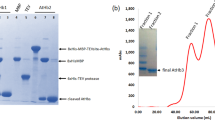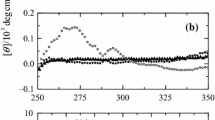Abstract
The pH dependence of proteins is related to the thermodynamic stability and electrostatic interactions in the native state of a protein. Here we report the pH-induced conformational transition of the heme protein leghemoglobin (Lb) isolated from root nodules of the leguminous plant Arachis hypogea. Unlike the other heme proteins myoglobin, hemoglobin, and cytochrome c, the structural characteristics and interactions of Lb is almost unknown, though its functional importance is already established since it binds oxygen to maintain the environment for N2 fixation. We investigated pH-induced unfolding of this protein and identified a number of conformational isomers using multiple fluorescence observables as a function of pH titration. We have characterized the acid- and base-induced conformational transitions among the structural states over the pH range 2–11. Depending on the solution conditions, Lb can exist in one of three phases: pH 2, 3, 4; pH 5, 6, 7; pH 8, 9, 10. The secondary structure as revealed by CD spectroscopy indicated the maximum percentage of α-helix to be present at pH 7, where the structure of Lb is also most rigid according to fluorescence anisotropy experiments. The fluorescence lifetime of tryptophan was observed to be maximum at pH 10 and minimum at pH 6, suggesting unfolding transitions of Lb. Thus, alteration of the microenvironment of the globin moiety during pH transition ultimately leads to the conformational change of this monomeric protein Lb.
Similar content being viewed by others
Abbreviations
- a.a.:
-
amino acid residues
- CD:
-
circular dichroism
- Lb:
-
leghemoglobin
References
Gros, G., Wittenberg, A. B., and Jue, T. (2010) Myoglobin old and new clothes: from molecular structure to function in living cells, J. Exp. Biol., 213, 2713–2725.
Atanasov, B. P., and Zhizheskaia, G. Ia. (1975) Acid-alkaline equilibrium of the ferri-leghemoglobin of the lupine (Lupinus luteus L.). Spectral studies, Mol. Biol. (Moscow), 9, 491–501.
Krasnobaeva, N. N., and Atanasov, B. P. (1978) Lupine leghemoglobin affinity to ligands. The effect of pH and buffer nature, Mol. Biol. (Moscow), 12, 1239–1245.
Fuchsman, W. H., and Appleby, C. A. (1979) CO and O2 complexes of soybean leghemoglobin: pH effects upon infrared and visible spectra. Comparisons with CO and of myoglobin and hemoglobin, Biochemistry, 18, 1309–1321.
Voet, D., and Voet, G. J. (2008) Fundamentals of Biochemistry, 3rd Edn., John Wiley & Sons.
Ellis, P. J., Appleby, C. A., Guss, J. M., Hunter, W. N., Ollis, D. L., and Freeman, H. C. (1997) Structure of ferric soybean leghemoglobin a nicotinate at 2.3 Å resolution, Acta Cryst., D53, 302–310.
Harutyunyan, E. H., Safonova, T. N., Kuranova, I. P., Popov, A. N., Teplyakov, A. V., Obmolova, G. V., Rusakov, A. A., Vainshtein, B. K., Dodson, G. G., and Wilson, J. C. (1995) The structure of deoxy- and oxy-leghemoglobin from lupine, J. Mol. Biol., 251, 104–115.
Tzoneva, R., and Michonova-Alexova, E. I. (1998) A calorimetric study of pH-dependent thermal unfolding of leghemoglobin from soybean, BBA, Sec. Bioenerg., 1364, 420–424.
Boulton, M., Rozanowska, M., and Rozanowska, B. (2001) Retinal photodamage, J. Photochem. Photobiol. B. Biol., 64, 144–161.
Appleby, C. A., Nicola, N. A., Hurrel, J. G. R., and Leach, S. J. (1975) Characterization and improved separation of soybean leghemoglobins, Biochemistry, 14, 4444–4450.
Navascues, J., Perez-Rontome, C., Gay, M., Marcos, M., Yang, F., Walker, F. A., Desbois, A., Abian, J., and Becana, M. (2012) Leghemoglobin green derivatives with nitrated hemes evidence production of highly reactive nitrogen species during aging of legume nodules, PNAS, 109, 2660–2665.
Basak, P., and Bhattacharyya, M. (2013) Intrinsic tryptophan fluorescence and related energy transfer in leghemoglobin isolated from Arachis hypogea, Turk. J. Biochem., 38, 9–13.
Ingersoll, M. C., and Strollo, C. M. (2007) Steady state fluorescence anisotropy to investigate flavonoids binding to proteins, J. Chem. Educ., 84, 1313–1315.
Amiri, M., Jnakeje, K., and Albani, J. R. (2010) Origin of fluorescence lifetimes in human serum albumin. Studies on native and denatured protein, J. Fluoresc., 20, 651–656.
Albani, J. R. (2011) Sub-structures formed in the excited state are responsible for tryptophan residues fluorescence in β-lactoglobulin, J. Fluoresc., 21, 1683–1687.
Lakowicz, J. R. (1999) Principle of Fluorescence Spectroscopy, 2nd Edn., Kluwer, New York.
Losytskyy, M. Y., Kovalska, V. B., Varzatskii, O. A., Sergeev, A. M., Yarmoluk, S. M., and Voloshin, Y. Z. (2013) Interaction of the iron(II) cage complexes with proteins: protein fluorescence quenching study, J. Fluoresc., 23, 889–895.
Zaidi, N., Ahmad, E., Rehan, M., Rabbani, G., Ajmal, M. R., Zaidi, Y., Subbarao, N., and Khan, R. H. (2013) Biophysical insight into furosemide binding to human serum albumin: a study to unveil its impaired albumin binding in uremia, J. Phys. Chem. B, 117, 2595–2604.
Correa, D. H. A., and Ramos, C. H. I. (2009) The use of circular dichroism spectroscopy to study protein folding, form and function, Afr. J. Biochem. Res., 3, 164–173.
Ahmad, B., Parveen, S., and Khan, R. H. (2006) Effect of albumin conformation on the binding of ciprofloxacin to human serum albumin: a novel approach directly assigning binding site, Biomacromolecules, 7, 1350–1356.
Chen, Y. H., Yang, J. T., and Martinez, H. (1972) Determination of the secondary structures of proteins by circular dichroism and optical rotatory dispersion, Biochemistry, 11, 4120–4131.
Rami, B. R., and Udgaonkar, J. B. (2001) pH-jumpinduced folding and unfolding studies of barstar: evidence for multiple folding and unfolding pathways, Biochemistry, 40, 15267–15279.
McPhie, P. (1975) pH dependence of the thermal unfolding of ribonuclease A, Biochemistry, 11, 879–883.
Bhattacharya, M., Jain, N., Bhasne, K., Kumari, V., and Mukhopadhyay, S. (2011) pH-induced conformational isomerization of bovine serum albumin studied by extrinsic and intrinsic protein fluorescence, J. Fluoresc., 21, 1083–1090.
Ortiz de Montellano, P. R. (2009) Hemes in biology, in Wiley Encyclopedia of Chemical Biology, John Wiley & Sons, Inc., pp. 240–249.
Furuyama, K., Kaneko, K., and Vargas, P. D. (2007) Heme as a magnificent molecule with multiple missions: heme determines its own fate and governs cellular homeostasis, Tohoku J. Exp. Med., 213, 1–16.
Padmanaban, G., Venkateswar, V., and Rangarajan, P. N. (1989) Haem as a multifunctional regulator, Trends Biochem. Sci., 14, 492–496.
Smerdon, S. J., Krzywda, S., Wilkinson, A. J., Brantley, R. E., Jr., Carver, T. E., Hargrove, M. S., and Olson, J. S. (1993) Serine 92 (F7) contributes to the control of heme reactivity and stability in myoglobin, Biochemistry, 32, 5132–5138.
Olson, J. S., Mathews, A. J., Rohlfs, R. J., Springer, B. A., Egeberg, K. D., Sligar, S. G., Tame, J., Renaud, J. P., and Nagai, K. (1988) The role of the distal histidine in myoglobin and hemoglobin, Nature, 336, 265–266.
Quillin, M. L., Arduini, R. M., Olson, J. S., and Phillips, G. N., Jr. (1993) High-resolution crystal structures of distal histidine mutants of sperm whale myoglobin, J. Mol. Biol., 234, 140–155.
Grunwald, E. W., and Richards, M. P. (2006) Studies with myoglobin variants indicate that released hemin is the primary promoter of lipid oxidation in washed fish muscle, J. Agric. Food Chem., 54, 4452–4460.
Hargrove, M. S., and Olson, J. S. (1996) The stability of holomyoglobin is determined by heme affinity, Biochemistry, 35, 11310–11318.
Grandori, R., Schwarzinger, S., and Muller, N. (2000) Cloning, overexpression and characterization of micromyoglobin: a minimal heme-binding fragment, Eur. J. Biochem., 267, 1168–1172.
Author information
Authors and Affiliations
Corresponding author
Additional information
Published in Russian in Biokhimiya, 2014, Vol. 79, No. 11, pp. 1539–1547.
Rights and permissions
About this article
Cite this article
Basak, P., Pattanayak, R., Nag, S. et al. pH-induced conformational isomerization of leghemoglobin from Arachis hypogea . Biochemistry Moscow 79, 1255–1261 (2014). https://doi.org/10.1134/S0006297914110133
Received:
Revised:
Published:
Issue Date:
DOI: https://doi.org/10.1134/S0006297914110133




